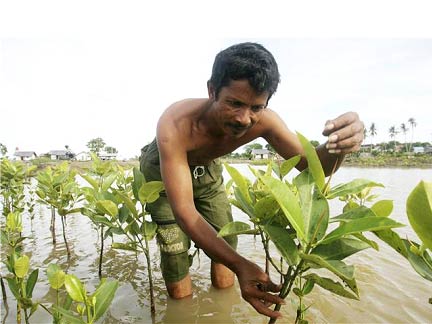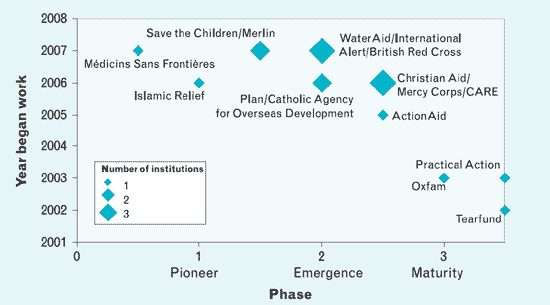 |
Megan Rowling finds that confused definitions and capacity constraints are holding back aid agencies’ responses to climate change adaptation. |
| The author is a journalist for the humanitarian news website Reuters AlertNet, where she coordinates a project to strengthen media coverage of the humanitarian impacts of climate change. | |
Two years ago at a conference about living with climate change, development economist Jeffrey Sachs castigated the world for its inadequate response to global warming. "So far efforts have focused on mitigation - and with major actors not part of international climate agreements, we haven’t really got a great strategy there," he said. "But even less have we put together a strategy together for adaptation. There is no post box for countries such as Chad and others affected by climate change to write to for help."
Aid workers were noticeable by their absence at that meeting - but they have since come to recognize the risks for the vulnerable countries in which they work. At a recent workshop on communicating climate change, one aid agency colleague remarked that news editors no longer get excited about stories along the lines of "poor people to be worst hit by climate change." This is a good sign because it means the message has at least been delivered to the right address. What remains challenging is the response.
Most relief and development groups have now accepted the need to integrate climate change into their strategy and programming. They are working to boost people’s resilience to cope with, and adapt to, the consequences of climate change. Some are advocating for a more just international policy framework for tackling climate change. Yet progress is uneven, and there is little critical evaluation of non-governmental (NGO) responses. A survey of international NGOs (INGOs) conducted earlier this year sheds some light on the knowledge gaps.
This article summarizes the findings and conclusions of the research, drawn from sixteen questionnaire responses and six interviews. Of the participating INGOs, ten are active in both relief and development - ActionAid, the Catholic Agency for Overseas Development, CARE, Christian Aid, Islamic Relief, Mercy Corps, Oxfam, Plan (United Kingdom), Save the Children and Tearfund; three are active mainly in development - International Alert (peace building), Practical Action and WaterAid; and three in humanitarian work - Merlin, Médicins Sans Frontières and the British Red Cross.
While the data reflects their climate change responses in the first quarter of 2008, some organizations will have advanced since completing the survey.
Strategic responses to climate change
In the past two years, climate change has risen decisively up NGO agendas. Of the sixteen organizations researched, six rated climate change as a top priority and seven as an important issue. Three said it was a low priority: Islamic Relief because it had not been perceived as a key factor in poverty reduction; Médicins Sans Frontières because it responds to disasters irrespective of their causes; and Plan because of too many competing priorities. None said it was of "no concern". Eleven did not start working formally on climate change until 2006, with Tearfund giving the earliest date of 2002. Fourteen respondents said climate change would become more important in the coming decade, with only Tearfund arguing it would become less so after completion of a programme to mainstream environmental sustainability.
Seven respondents identified poor understanding of, or doubts about, climate change as an obstacle to getting it onto the strategic agenda. The British Red Cross said some staff were concerned that climate change was the latest aid fad. CARE noted that its response had been significantly delayed by "misinformation" on climate change in the United States. Three factors were seen as key to winning organizational buy-in: climate change "champions" who have been instrumental in raising awareness and enlisting top-level support; membership of climate change coalitions, which has provided valuable impetus; and framing climate change in a way that relates to organizational priorities.
 |
|
A farmer checks his mangrove trees at Lamnga Beach
in Aceh Besar, Indonesia. Mangroves protect coastal
areas from erosion caused by severe weather
© REUTERS/Tarmizy Harva. Courtesy Reuters AlertNet |
Respondents have used a variety of lenses, but nearly all made the link between climate change and their work on disaster preparedness and disaster risk reduction (DRR). For some, this angle has helped play down the "newness" of climate change and its potential strain on capacity. Ten took the view that climate change threatens the effectiveness of their development and poverty reduction work. Seven - mainly campaigning groups - have presented climate change as a global justice issue for which rich polluting nations should compensate developing countries. Christian Aid probably went furthest along this path, warning that the poor risk losing their "development rights in a climate-constrained world."
Climate change activities
Twelve respondents were doing external work on adaptation (advocacy and campaigns), and eleven were undertaking programme-based adaptation work. Eleven were taking internal action to audit and reduce their emissions, and ten were lobbying externally for cuts in greenhouse gas emissions. One (Médicins Sans Frontières) said it had no climate change-related activities, while Merlin listed only DRR work. NGOs engaged only in humanitarian work indicated a reluctance to engage in what they see as political campaigning on emissions.
On adaptation, 11 out of thirteen eligible iNGOs said they were integrating it into their disaster response/mitigation work, and ten out of thirteen eligible respondents into their development work. The main focus was projects and community-based measures to boost resilience to disasters and adapt to climate change, together with related research. This took precedence over systematic climate risk management activities, such as portfolio screening and climate-proofing.
The survey revealed considerable confusion over what climate change adaptation means in practice. Some NGOs presented it as interchangeable with their DRR work, while others argued the need to make a clear distinction. Christian Aid listed one goal of its adaptation work as "to develop a methodology for the additional nature of climate change adaptation programmes (not just rebadging livelihoods or DRR programmes)."
Oxfam noted the difficulty of distinguishing between "existing, sometimes major, climate changes," such as drought in the Sahel, and new trends and events that can be attributed to climate change as "a human-made, accelerating threat." ActionAid cited a lack of clarity on what work qualifies as climate change adaptation within related areas such as food security and DRR.
Funding
Ten respondents said they had financed adaptation activities from existing programme budgets, and seven had accessed external grants. Seven said their adaptation work has been compromised by a lack of funds - including most respondents that are in a position to scale up their work. For the rest, financing has not been a problem, mainly because they are still planning or piloting activities. This finding suggests there may be less funding available for NGO adaptation work than widely perceived. CARE argued that some donors have earmarked significant amounts for adaptation but are still deciding how to allocate the money.
Mainstreaming
Only five organizations said they have a policy of mainstreaming climate change adaptation across their operations (CARE, Mercy Corps, Practical Action, Tearfund and WaterAid), and most are in the early stages of implementation. Activities include developing climate risk assessment tools and guidelines for integrating adaptation into programme planning and monitoring and evaluation methods, research on best practice and training staff and partners. While mainstreaming is widely regarded as the right approach, several respondents said they were still working out how to do it in practice. Only Christian Aid specified that it did not see adaptation as a mainstreaming agenda.
Capacity
Most NGOs are allocating an increasing amount of human and financial resources to climate change work. Among the respondents, thirteen had staff working on climate change including policy coordinators (seven), analysts/researchers (six) and campaigners (four). Five had a climate policy team and four a climate change committee. While a small team may be adequate to kick-start work at headquarters, the study found that insufficient capacity is holding back some agencies’ efforts to scale up adaptation and integrate it into country programmes.
Practical Action cited a lack of resources in three areas: expanding programmes beyond two or three country offices; policy work; and staff capacity building. The Red Cross/Red Crescent Climate Centre also identified its biggest challenge as "massive capacity building on the widest possible scale." According to Maarten van Aalst, the Centre’s climate specialist, the main need is to train staff across disciplines at national and local levels so they can start implementing adaptation in the field. He argued that the aid sector has yet to grasp the size and urgency of this task, with much discussion on tools and methodologies but not enough practical implementation.
Advocacy
Most survey participants aim to shape public policy on climate change. Of the eight with campaigns on the theme, six have campaigned on adaptation and six on mitigation. Five INGOs said they are working to raise the profile of adaptation in United Nations climate negotiations, and five are pushing for more international financing for adaptation. Funding is becoming an increasingly contested issue, as the amount in the pipeline falls far short of what is needed. Oxfam said it was also advocating for just and equitable adaptation, and International Alert aims to persuade policy makers that adaptation should be based on ownership by local communities. A small number (including Oxfam, Practical Action and ActionAid) are also seeking to influence governments in developing countries via national branches and partner organizations or by strengthening local civil society.
Where next?
The survey also questioned NGOs about the focus of their climate change work going forward. Analysis of open responses suggested adaptation is more strategically important than mitigation for both programme and policy work. DRR is favoured as a way of boosting resilience to weather hazards and climate variability. Reducing vulnerability, both in general and to specific weather shocks, is widely perceived as a "no regrets" option that will build capacity to cope with future climate change and improve lives, irrespective of which climate scenarios materialize. Fewer organizations indicated they are planning activities in the area of clean development. Only CARE, Mercy Corps and Practical Action highlighted projects to help poor communities gain access to cleaner energy sources and carbon markets. If sustainable development is to become a reality, however, this may be an area that merits greater attention.
How climate smart are INGOs?
Participating INGOs were mapped against a three-phase climate smart transition process drawn up by Thomas Tanner and Tom Mitchell at the Institute of Development Studies, with the aim of evaluating real-world progress across the aid sector. Being "climate smart" is defined as "an organization’s ability to manage existing and future climate risks while taking advantage of opportunities associated with climate change." The key features can be summarized as follows.
- Phase one (pioneer): Pioneers build the case for organizational response, drawing on external knowledge. Internal awareness-raising and external networking are key.
- Phase two (emergence): Champions draw in human resources and establish a vision and strategy for mainstreaming. Focus is on knowledge management and messaging. Internal green credentials are assessed.
- Phase three (maturity): Climate change is internalized and mainstreamed throughout the organization’s mandate, strategy and operational plans. Top-level political will drives funding and activities, including risk-screening. Knowledge is communicated to empower supporters, enable adaptation and make the case for political action.
 |
| How climate smart are INGOs? |
The findings of this research support Tanner and Mitchell’s conclusion that NGOs are at different stages in the transition to becoming climate smart and face unique challenges. The diagram above plots the year survey participants began working on climate change against the point they were judged to have reached in the transition process, as of the first quarter of 2008. Seven of the sixteen respondents had entered the third "maturity" phase or were moving into it, with the rest spread across phases one and two.
Large campaigning NGOs with a broad relief and development mandate appear to be leading the pack, with humanitarian organizations - especially medical aid agencies - lagging behind. There is a correlation between the length of time an organization has been working on climate change and the extent of its transformation. Nearly all INGOs surveyed have set themselves on the path to becoming climate smart, and some late starters have made quite rapid progress. However, none have completed the process of mainstreaming climate change. While a few organizations are getting close to earning the climate smart label, there is some way to go before it becomes applicable across the whole aid sector.
Conclusions
Confusion over which aid activities qualify as climate change adaptation has hampered implementation, highlighting a need for clearer definitions and processes to support decision making and learning. Re-labelling existing projects as adaptation to obtain funding in the short-term could prove counter-productive once the effects of climate change become more evident and demand a bigger response. INGOs and donors could help reduce this risk by working out how to finance activities that build resilience to climate change but might go unfunded unless they can be classified as pure adaptation.
There is an urgent need for action learning on community-based adaptation, and INGOs will be instrumental in determining whether adaptation follows a grassroots or top-down model. They should act as innovators for community-based adaptation - developing and testing tools and methodologies in the field and sharing their results with the wider aid community. Progress could be thwarted, however, by a poor grasp of how much capacity building this requires. Limiting adaptation work to DRR or failing to manage longer-term climate risk because of insufficient capacity and/or knowledge could result in decisions that actually increase vulnerability to longer-term climate stresses.
Climate change appears to offer INGOs a fresh opportunity to forge an alternative development vision rooted in environmental sustainability. Justice-based advocacy on climate change clearly reflects an ambition to go beyond the technicalities of adaptation and to rethink orthodox notions of development. Yet the transformation to more sustainable development practices will be contested and complex. In the meantime, INGOs should aim for more equitable adaptation outcomes while continuing to address the underlying causes of climate change.
Aid agencies can help build the evidence base on climate change by documenting and communicating the experiences of their staff, partners and beneficiaries. In this way they can give climate change a "human face" and make connections between people’s lives, inspiring political action. INGOs are developing a more nuanced understanding of poverty and climate impacts and should use this to prevent the "adaptation apartheid" scenario warned of by Archbishop Desmond Tutu in the 2007/8 Human Development Report. Some aid agencies have begun investigating the adaptation needs of vulnerable groups such as children and women, and this research should be fed into policy processes. INGOs and their partners could also promote greater involvement of local communities in planning and implementing adaptation measures.
INGOs are well placed to bridge the gap between high-level policy processes and communities at the sharp end of climate change, and should aim to facilitate the inclusion of marginalized groups in international negotiations. Besides calling for increased adaptation financing, they should also push for distribution mechanisms that ensure funding reaches the most vulnerable. At a national level - where developing country governments often lack capacity to respond to climate change - INGOs could support country offices, partner organizations and civil society in identifying local adaptation needs and getting them onto the policy agenda. Conversely, they have a key role to play in disseminating scientific and technical knowledge in accessible ways. This will require stronger relationships with climate scientists and researchers. As Saleemul Huq of the International Institute for Environment and Development argues, "we need a system that learns and does at the same time; and shares learning effectively in real time."
Further information
Megan Rowling, Thomson Reuters Foundation, The Reuters Building, 30 South Colonnade, Canary Wharf, London E14 5EP, United Kingdom. Fax: +44-207-5428599. Email: megan.rowling@thomsonreuters.com. Web: www.alertnet.org.
On the Web
For information on activities in the area of climate change by the organizations that have reached "maturity", visit the Oxfam, Practical Action and Tearfund websites.